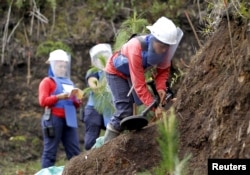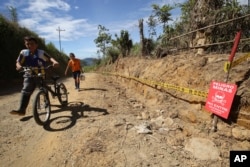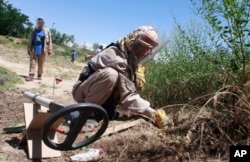The United States is doubling down on aid programs for de-mining efforts in Colombia, a country that has the second most unexploded ordnance next to Afghanistan since 1990, as its government is making peace with the largest guerrilla rebel group after a decades-long conflict.
According to the latest "To Walk the Earth in Safety" report, which chronicles the U.S. government's efforts to rid the world of land mines, the U.S. has "provided more than $2.6 billion in assistance in more than 95 countries for Conventional Weapons Destruction programs."
Among the most notable of global de-mining initiatives is in Colombia, where the government reached a peace deal with the Marxist FARC rebel group in September. The deal was rejected in a plebiscite last month, but the two sides agreed upon a revised deal last weekend.
Washington has pledged an additional $46 million since September to support efforts to rid Colombia of land mines. That amount is more than what had been invested over the past five years.
From 2001 through 2015, the U.S. invested more than $43.2 million to support conventional weapons destruction in Colombia, including clearance, risk education and survivor assistance programs.
Efforts fall short
But critics said Washington could do more to clean up land mines, cluster munitions and other highly explosive ordnance in many countries where its military inflicted damage.
While "the United States' contribution to clearing minefields is world-leading and very valuable," said Jeff Abramson from Landmine and Cluster Munition Monitor, "the pace of mine clearance is not sufficient to meet the global goal of a mine-free world by 2025" — a goal declared by the Mine Ban Treaty members.
Abramson told VOA on Thursday that there are still "some 60 states with land mine contamination and 31 states with significant numbers of land mine survivors who have a right to assistance."
The Mine Ban Treaty, adopted in 1997 and entered into force in 1999, is a legally binding international agreement that bans the use, production, stockpiling and transfer of antipersonnel mines. It also places obligations on countries to clear affected areas, assist victims and destroy stockpiles.
The U.S. is not a state party of the Mine Ban Treaty, but has been participating as an observer in meetings for years.
"The U.S. must finally join the 1997 Mine Ban Treaty and destroy all of its stocks of the weapon," Human Rights Watch Arms Division director Steve Goose told VOA, if it "truly wants to be a global leader on the land mine issue."
Goose added that "helping to clean up the contamination is not enough. The U.S. should work to prevent and should condemn any use of antipersonnel mines by anyone."
Meeting set in Chile
A senior U.S. official told VOA on Thursday that Washington would attend the 15th Meeting of States Parties to the Mine Ban Treaty in Santiago, Chile, from November 28 to December 1.
The meeting is set to reaffirm commitment for completion of mine clearance and other treaty obligations by 2025.
While the U.S. stopped the export, production and acquisition of antipersonnel land mines, it still retains land mines for use on the Korean Peninsula, where the U.S. military is required to help defend South Korea against provocation from North Korea.
In Asia, 2015 marked a milestone in progress for the destruction of conventional weapons, when the government of Laos issued a commitment to conduct a national unexploded ordnance survey.
The majority of Laos' 17 provinces are contaminated with unexploded ordnance; most are of U.S. origin.
When President Barack Obama visited Laos in September, he announced $90 million in funding for a national survey of unexploded ordnance and for clearance efforts.














